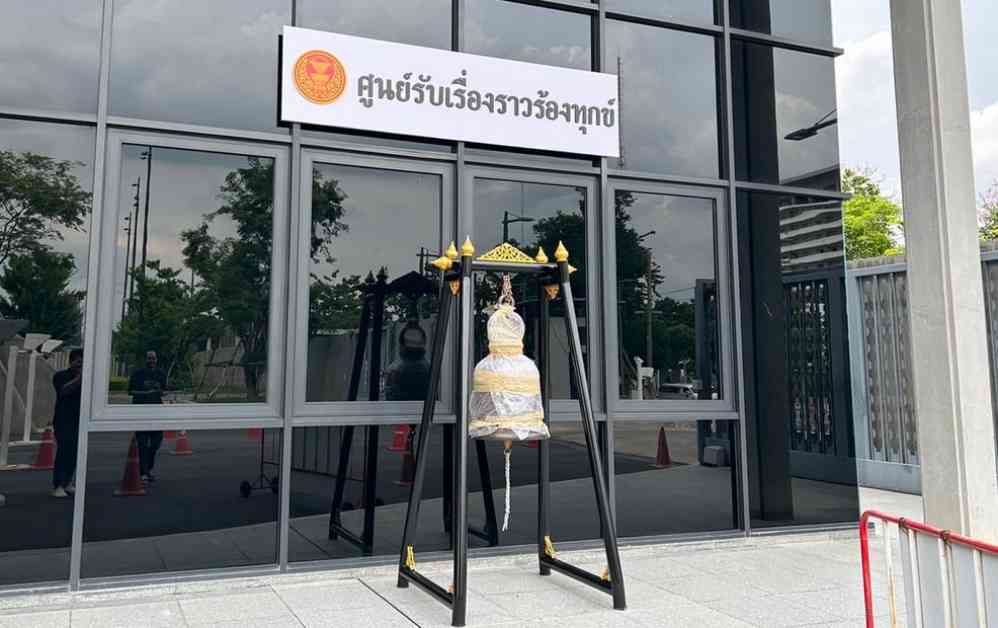Vice President’s Proposal Sparks Controversy
In a surprising move, the Vice President has proposed hanging a large bell in front of the Parliament building to serve as a complaint center for the public. This proposal has raised concerns and sparked controversy among citizens and lawmakers alike. The bell, which has already been installed in front of the building, has become a focal point of criticism and debate.
The decision to hang the bell was made by Mr. Pichet Cheumuangpan, the Deputy Speaker of the House of Representatives, to symbolize the accessibility of the complaint center for the general public. The bell is intended to make it easier for people to voice their grievances without having to go through bureaucratic channels. Instead of having to physically submit written complaints at designated locations, citizens can simply ring the bell and have their concerns addressed by staff inside the center.
Historical Significance and Modern Context
Critics of the proposal have pointed out that the hanging of a bell in front of the Parliament building harkens back to a bygone era, reminiscent of the traditional practice of using bells to signal important announcements or gatherings. This move has been seen as a step backward in the government’s efforts to modernize and streamline its operations, particularly in light of the “smart parliament” initiative that has been in place since the tenure of former Speaker Chuan Leekpai.
The decision to install the bell has also been viewed as a departure from the principles of a smart and efficient government, as it introduces a potentially archaic and inefficient method of communication between the public and their representatives. While the intent behind the proposal may have been to make the complaint process more accessible and visible to the public, the choice of using a bell as a symbol has been met with skepticism and criticism.
Reactions from the Public and Lawmakers
The installation of the bell in front of the Parliament building has elicited mixed reactions from both the public and lawmakers. Some citizens have expressed support for the initiative, viewing it as a tangible sign of the government’s willingness to listen to their concerns. They believe that the bell will serve as a convenient and visible way for them to voice their grievances without having to navigate bureaucratic hurdles.
On the other hand, many lawmakers have raised concerns about the implications of the bell’s installation. They worry that it may undermine the government’s efforts to modernize its operations and create a more efficient and transparent system of governance. Some have questioned the symbolism behind the bell and whether it truly reflects the values and principles of a modern democracy.
In response to the criticism, Mr. Pichet Cheumuangpan has defended the decision to install the bell, stating that it is meant to serve as a practical and accessible means for the public to communicate with their representatives. He has emphasized that the complaint center will be staffed by officials who will be responsible for addressing the concerns raised by citizens in a timely manner.
Looking Ahead: The Future of the Complaint Center
As the controversy surrounding the installation of the bell continues to unfold, many are wondering about the future of the complaint center and how it will function in practice. While the center has not yet officially opened to the public, it is expected to do so in the near future.
It remains to be seen how effective the complaint center will be in addressing the grievances of the public and whether it will succeed in improving communication between citizens and their representatives. The success of the center will ultimately depend on how well it is managed and how responsive it is to the needs and concerns of the public.
In conclusion, the proposal to hang a bell in front of the Parliament building has sparked controversy and raised questions about the government’s commitment to modernization and efficiency. While some view it as a positive step towards making the complaint process more accessible, others see it as a regressive move that undermines the government’s efforts to create a more transparent and responsive system of governance. Only time will tell how the complaint center will function and whether it will succeed in meeting the needs of the public.




















